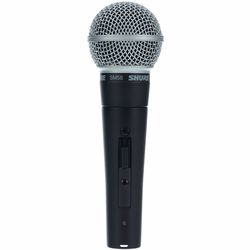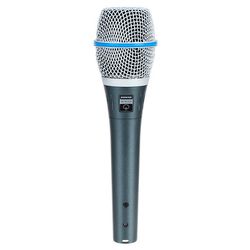Can you use a vocal microphone in the studio?
Of course, stage vocal microphones can also be used off-stage in the recording studio. In fact this is a common occurrence even in a professional context – many an album has been recorded with mic in hand, capturing some of that famous live energy! And many of the microphones in this category are all-rounder microphones, too: They can be used to pick up guitar amps, drums, wind instruments, and indeed almost anything else.
What is a "cardioid" microphone?
Cardioid is a term used to refer to the most common microphone polar pattern, i.e. its directional sensitivity. Cardioid – from the Greek word for "heart" – means that the microphone is most sensitive at the front, with decreasing pick-up at the sides and lowest sensitivity at the rear. There are also supercardioid and hypercardioid mics, which are even more directional, almost completely blocking out lateral sound, for example the other instruments on stage. However, they are not quite as insensitive at the rear.
Is there a difference between microphones for singing and speaking?
Every vocal microphone – that is, one suitable for vocals in the sense of singing – can also be used for speech. Indeed, they very frequently are: The microphones on lecterns, in churches, and at conference centres and the like are often simply vocal microphones.
What is the difference between a condenser microphone and a dynamic microphone?
One way of fundamentally categorising microphones is the principle by which they convert sound waves in the air into an electrical signal. In all vocal microphones, the sound moves a diaphragm, an extremely thin membrane.
• Dynamic microphones have, directly attached to the diaphragm, a coil that moves back and forth in a magnetic field. From a technical standpoint, this principle is relatively straightforward, requiring very little in the way of complicated electronics. Generally speaking, dynamic vocal microphones are less expensive than condenser microphones, albeit with rather less detail and treble. On the other hand, they are particularly robust!
• Condenser vocal microphones have a particularly thin diaphragm that can vibrate freely. This makes the sound particularly detailed and clear – however, this type of microphone is usually somewhat more expensive. Additionally, condenser microphones require a 48V phantom power supply.
• For the most part, ribbon microphones are not typically considered stage microphones, because they are just too sensitive. However, the AEA KU5A is a popular ribbon microphone that was explicitly designed for this purpose, and as such it is suitably robust.
Important manufacturers of vocal microphones
There are a number of notable vocal microphones that have proven their worth on stages around the world over many years. These include the Shure SM58, famous for its miraculous robustness and assertive sound. However, Shure also produces many other models in different price categories. Another important player is Sennheiser, still based in Hanover in northern Germany; Sennheiser has a huge range of microphones and audio products. Other important companies include Audio-Technica, EV, Rode, Beyerdynamic, Audix, AKG, DPA, and Neumann. Among the more noteworthy newer companies on the market are Lewitt and Austrian Audio. Thomann's in-house brand the t.bone offers a wide range of different vocal microphones, with value for money guaranteed.





)
)



